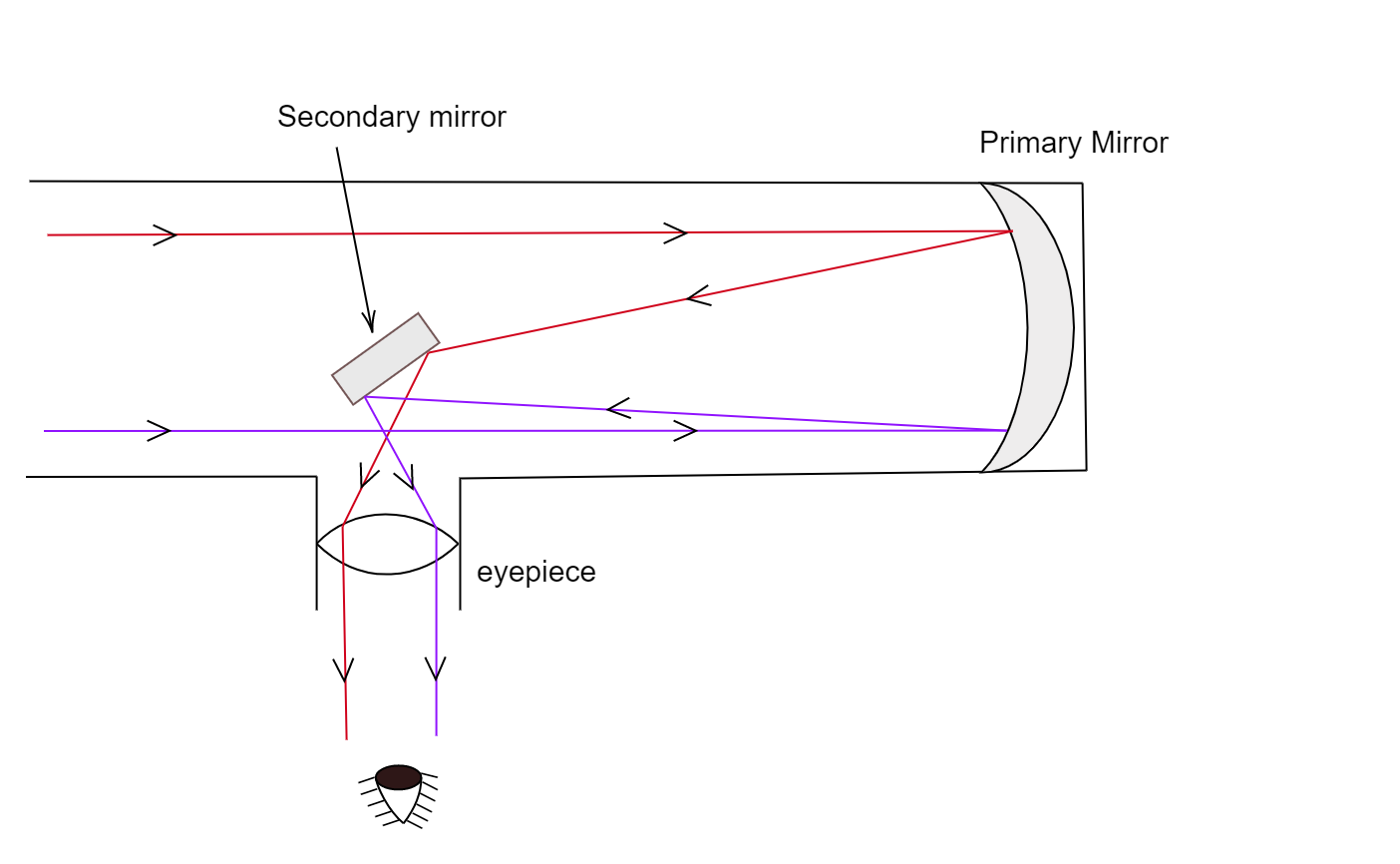
Draw ray diagram of reflecting telescope for image formation. How can we increase its resolving power?
Answer
520.5k+ views
Hint: A reflecting telescope uses two mirrors to form the image of a distant object, the use of a mirror instead of an optical lens reduces the chromatic aberration caused by it. The resolving power of the telescope depends on the diameter of the objective.
Complete answer:
The first reflecting telescope was developed by Newton in the 17th century. Before this optical lenses were used to form images from different optical devices. But there is a similarity in the behaviour of spherical mirrors and optical lenses. This property of mirrors was used by Newton to construct the Reflecting Telescope.
A telescope is used to provide angular magnification, which helps to observe distant objects with ease. It has an objective and eyepiece. The objective is made large in order to collect as much light as possible. So in a telescope, to increase the resolving power, a large diameter of the objective is required.
In a reflecting telescope, the objective is a large concave mirror, which collects light from the distant and faint sources, and focuses it on its focus as the rays entering the telescope are parallel. Using a parabolic reflecting surface also removes the spherical aberration. The image is focussed inside the tube of the telescope. So to reach the eyepiece, it is diverted using a convex or plane mirror. Then the image is magnified in the eyepiece.
The following is the ray diagram of a reflecting telescope-

Note:
Small lenses do not show many aberrations because they are thin. But when large lenses are used the light has to be refracted for a much larger distance which creates some dispersion, and is also reduced in intensity due to frequent absorption and emission. Similarly, at bigger scales spherical mirrors do not form images into their focus, to overcome these parabolic mirrors are used in reflecting telescopes.
Complete answer:
The first reflecting telescope was developed by Newton in the 17th century. Before this optical lenses were used to form images from different optical devices. But there is a similarity in the behaviour of spherical mirrors and optical lenses. This property of mirrors was used by Newton to construct the Reflecting Telescope.
A telescope is used to provide angular magnification, which helps to observe distant objects with ease. It has an objective and eyepiece. The objective is made large in order to collect as much light as possible. So in a telescope, to increase the resolving power, a large diameter of the objective is required.
In a reflecting telescope, the objective is a large concave mirror, which collects light from the distant and faint sources, and focuses it on its focus as the rays entering the telescope are parallel. Using a parabolic reflecting surface also removes the spherical aberration. The image is focussed inside the tube of the telescope. So to reach the eyepiece, it is diverted using a convex or plane mirror. Then the image is magnified in the eyepiece.
The following is the ray diagram of a reflecting telescope-

Note:
Small lenses do not show many aberrations because they are thin. But when large lenses are used the light has to be refracted for a much larger distance which creates some dispersion, and is also reduced in intensity due to frequent absorption and emission. Similarly, at bigger scales spherical mirrors do not form images into their focus, to overcome these parabolic mirrors are used in reflecting telescopes.
Recently Updated Pages
Class 11 Question and Answer - Your Ultimate Solutions Guide

Master Class 11 Accountancy: Engaging Questions & Answers for Success

Master Class 11 Physics: Engaging Questions & Answers for Success

Master Class 11 Business Studies: Engaging Questions & Answers for Success

Master Class 11 Maths: Engaging Questions & Answers for Success

Master Class 11 Chemistry: Engaging Questions & Answers for Success

Trending doubts
1 ton equals to A 100 kg B 1000 kg C 10 kg D 10000 class 11 physics CBSE

Difference Between Prokaryotic Cells and Eukaryotic Cells

One Metric ton is equal to kg A 10000 B 1000 C 100 class 11 physics CBSE

What is the opposite of entropy class 11 chemistry CBSE

Proton was discovered by A Thomson B Rutherford C Chadwick class 11 chemistry CBSE

1 Quintal is equal to a 110 kg b 10 kg c 100kg d 1000 class 11 physics CBSE




